How the wreck of Royal Navy’s HMS Invincible was discovered by a lucky Portsmouth fisherman
and live on Freeview channel 276
By the age of seven he was scavenging the mud of Portsmouth Harbour to help support his family.
The illiterate mudlarker, who has lived in Portsmouth his whole life and currently resides in Eastney, grew up to become a career fisherman who learnt to haul a living from the waters of the Solent.
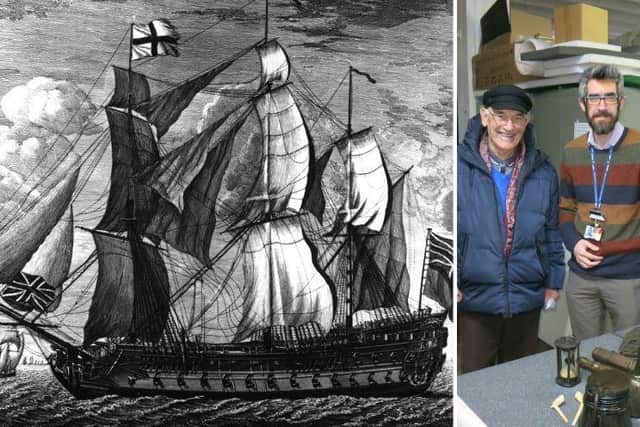

Advertisement
Hide AdAdvertisement
Hide AdAnd it was while at sea he made the discovery of a lifetime that would begin an uncanny journey of fortune in coming across items of archaeological significance that were centuries old.
But it was the discovery of pioneering warship HMS Invincible, which was originally a French 74-gun ship launched in October 1744 but captured by the Royal Navy in 1747, that Arthur will always be most associated with.
At the time of the Royal Navy’s capture of Invincible, there was not a single 74-gun ship in the British fleet.
But by 1805 at the Battle of Trafalgar, three quarters of British ships had the singular design - with the 74-gun ship becoming the backbone of all major navies of the world.
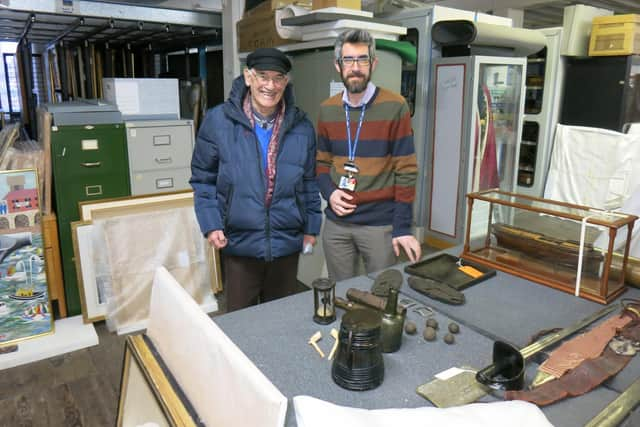

Advertisement
Hide AdAdvertisement
Hide AdInvincible was wrecked in 1758 after hitting a sandbank in the Solent where she remained for more than two centuries - until Arthur discovered her in May 1979.
While out on a routine fishing voyage three miles from Southsea beach, Arthur’s net snagged on a seabed obstruction. When eventually freed it came up with a piece of old timber.
But instead of cursing his luck and throwing it back he trusted his ‘feeling’ about it, noted the spot, and returned with John Broomhead, a diving friend.
Incredibly, the timber turned out to be part of Invincible.
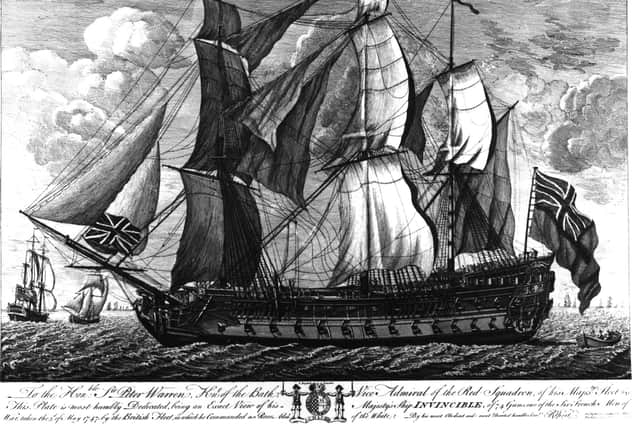

Arthur, now 86, who has had a book published about his exploits called Old Man of the Sea, said: ‘I had a gut feeling there was something there after I hit the seabed while out fishing with a friend.
Advertisement
Hide AdAdvertisement
Hide Ad‘It stopped the boat dead and then a piece of wood came up and I took it home.
‘When John came out with me I said “I’ve got a gut feeling there is something very special down there”. And I was right. My persistence paid off in the end.’
Deep sea dives revealed a ‘vast’ 200ft wooden vessel which was confirmed by experts as being Invincible.
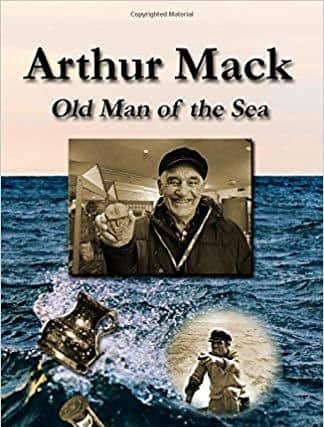

The discovery prompted backing from Chatham Historic Dockyard, a maritime museum based in Kent, for Arthur and John to carry out missions of discovery on Invincible in the 1980s.
Advertisement
Hide AdAdvertisement
Hide AdJohn, 71, who lives in Hayling Island and co-wrote the book with Brent Piniuta, said: ‘The moment that fully changed the course of both of our lives forever was when Arthur found Invincible.
‘It was at a lucky chance meeting that Arthur asked me to dive and see what it was that he’d accidentally caught his nets on.
‘There are no words to describe Arthur’s gift – it transcends conventional “luck” that most people may enjoy once in a blue moon.
‘Invincible had laid on the seabed for 240 years buried by sand. Other fishermen would have had their net caught on an obstruction and thought nothing of it but Arthur felt it was something special when he came across it.’
Advertisement
Hide AdAdvertisement
Hide AdArthur’s knack for finding artefacts also saw him discover one of the original ship logs from the captain in 1755, as well as items dating back over 1,000 years prior to this.
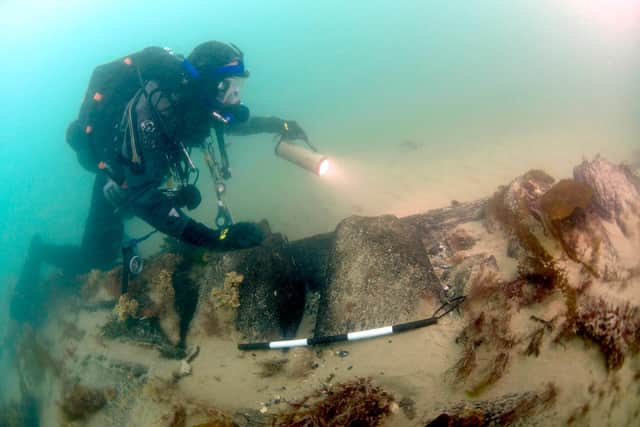

In Langstone Harbour he pulled out a Saxon log boat from 400 - 600 AD.
Arthur has also had the privilege to find carved Bronze Age pottery that had not been discovered before and now resides in Portsmouth Museum and Art Gallery.
But even on metal detector outings, Arthur would come up trumps.
Advertisement
Hide AdAdvertisement
Hide AdJohn said: ‘On every occasion I went with him, he lent me his spare detector and we would walk side by side along the beach. He would always find old coins, jewellery, and the like, whereas all I found was bottle tops and modern junk.
‘I accused him of having the more advanced detector and so he would swap mine for his “better” one. But it made no difference at all – the outcome was always the same. I actually believed the old coins found him and ignored me.’
With his passion for learning, Arthur taught himself to read and write and is now a respected figure in archaeological circles following his discoveries that can be found in museums across the south, while his contributions to maritime historical knowledge are now documented worldwide.
Although he no longer goes out to sea, Arthur still retains a love of the ocean and the stories it tells through artefacts lost centuries ago.
Advertisement
Hide AdAdvertisement
Hide AdIt is a far cry from his humble beginnings. ‘Everyone had nothing growing up - it was like living in the slums. When I left school I could hardly read,’ Arthur said.
‘It was really only when I found the wreck that I pulled my finger out. I then started going up to London to maritime museums and libraries.
‘I’ve discovered so many things - I just love history.’
Arthur and John retired from their diving missions on Invincible in 1991 before a £2.5m government project took over.
Now around 2,000 artefacts discovered at the site - including parts of the ship's hull, tobacco pipes and ceramic hair curlers - were due to go on display to the public this year at Chatham Dockyard as part of a National Museum of the Royal Navy’s travelling exhibition.
Advertisement
Hide AdAdvertisement
Hide AdAn exhibition on October 24 at Portsmouth Historic Dockyard will also showcase Arthur and John’s story of discovery on Invincible - complete with a large picture of Arthur.
The book is a legacy charity project with all sales donated to the museums that house Arthur’s archaeological finds including Portsmouth Historic Dockyard, Portsmouth Museum and Art Gallery, and Historic Dockyard Chatham.
Brent, who lives in Canada, revealed he could not turn down the opportunity to tell Arthur’s story. ‘Arthur’s a modest man from humble beginnings and someone who had a rough start in life,’ he said.
‘And yet he has succeeded so brilliantly in his many accomplishments, that up to now have gone largely unspoken. I didn’t want his story to be left untold.’
Advertisement
Hide AdAdvertisement
Hide AdTo buy a copy go to: www.amazon.co.uk/Arthur-Mack-Old-Man-Sea/dp/B08C4F7QK9
SEE ALSO: Cyclist takes on bike challenge
A message from the Editor, Mark Waldron
Thank you for reading this story. The dramatic events of 2020 are having a major impact on our advertisers and thus our revenues.
The News is more reliant than ever on you taking out a digital subscription to support our journalism. You can subscribe here for unlimited access to Portsmouth news and information online.
Every subscription helps us continue providing trusted, local journalism and campaign on your behalf for our city.
Comment Guidelines
National World encourages reader discussion on our stories. User feedback, insights and back-and-forth exchanges add a rich layer of context to reporting. Please review our Community Guidelines before commenting.